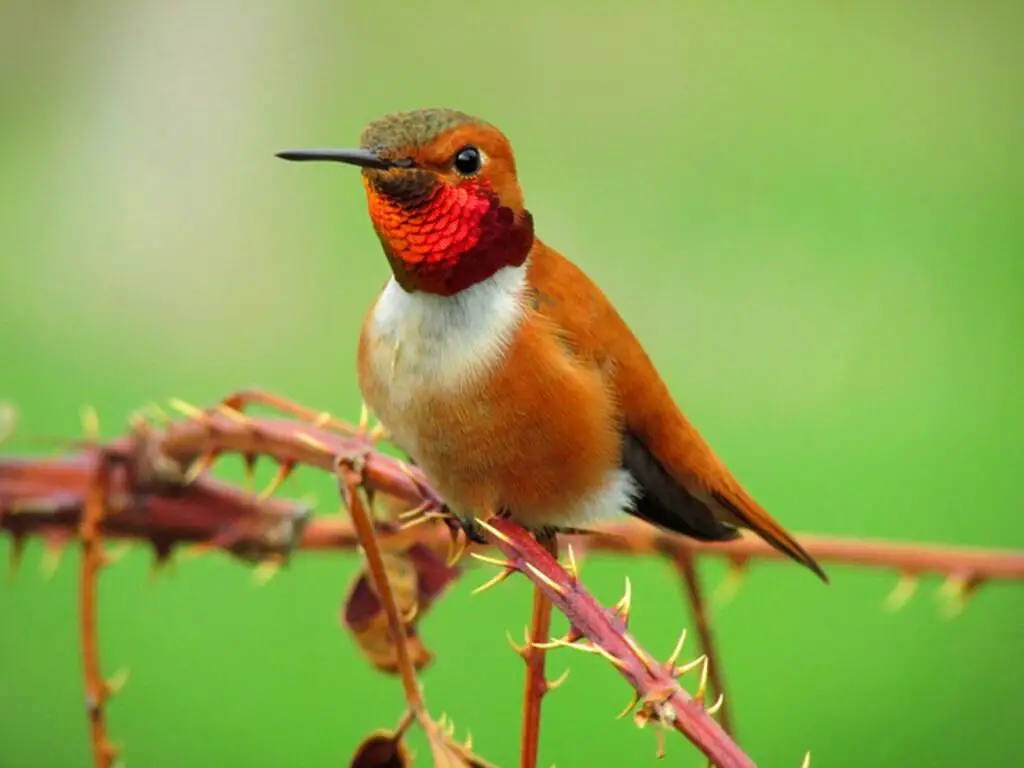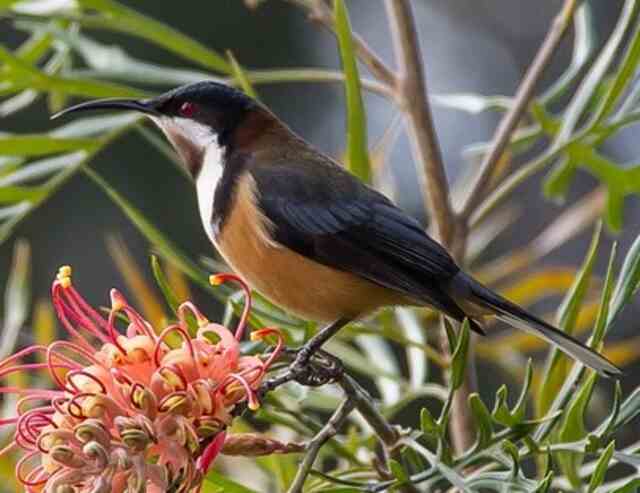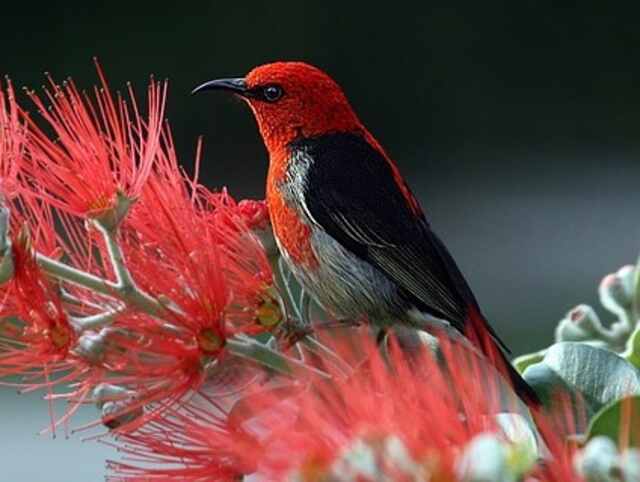Get ready to be amazed by these 17 bird species that look like hummingbirds! From their similar appearance to their hovering flight patterns and love for nectar, these birds are often mistaken for hummingbirds by birdwatchers and nature enthusiasts alike.
But despite their similarities, each of these birds has unique features and behaviors that set them apart. Join us as we introduce you to the fascinating world of hummingbird lookalikes!
Table of Contents
- 1 Common Hummingbirds in North America
- 2 Birds That Look Like Hummingbirds
- 2.1 Orange-Breasted Sunbird
- 2.2 Southern Double-Collared Sunbird
- 2.3 Crimson Sunbird
- 2.4 Malachite Sunbird
- 2.5 Malagasy Green Sunbird
- 2.6 Javan Sunbird
- 2.7 Lesser Double-Collared Sunbird
- 2.8 Purple-Throated Sunbird
- 2.9 Black Sunbird
- 2.10 Purple Sunbird
- 2.11 Temminck’s Sunbird
- 2.12 Olive-Backed Sunbird
- 2.13 New Holland Honeyeater
- 2.14 Eastern Spinebill
- 2.15 Brown-Throated Sunbird
- 2.16 Collared Sunbird
- 2.17 Scarlet Honeyeater
- 3 Conclusion
- 4 Author
Common Hummingbirds in North America
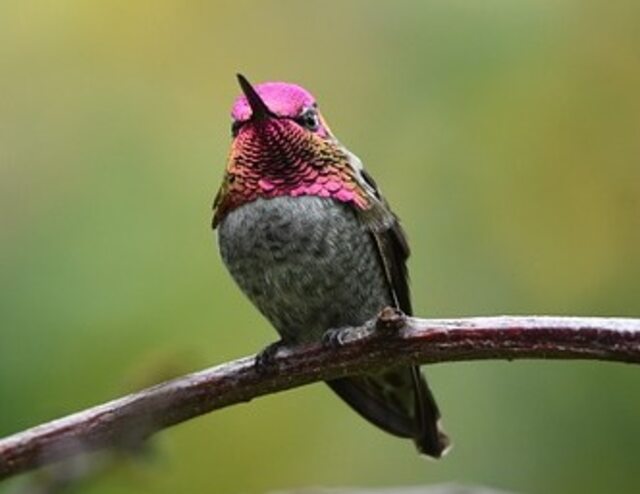
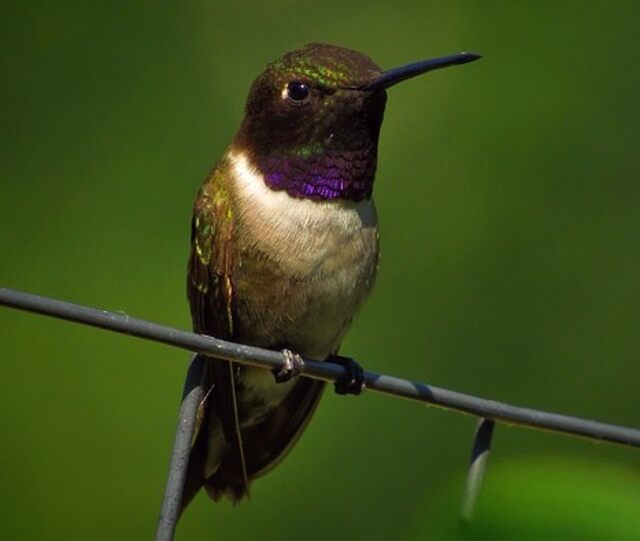
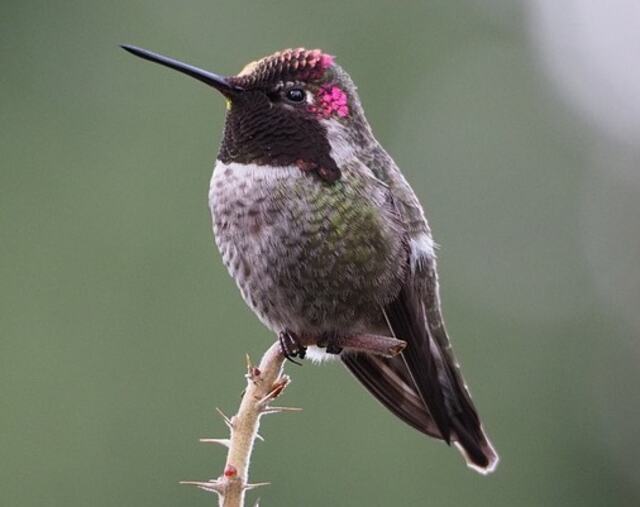
| Bird Name | Coloration | Distribution Range | Habitat | Diet | Habits |
|---|---|---|---|---|---|
| Ruby-throated Hummingbird | Green back, white underparts, ruby-red throat patch | Eastern and Central North America | Woodlands, gardens, and meadows | Nectar, insects, and tree sap | Males have elaborate courtship displays, fly in a distinctive “U” pattern |
| Black-chinned Hummingbird | Metallic green upperparts, black chin and throat | Western United States, Mexico | Arid and semi-arid habitats, scrubland | Nectar, small insects, and spiders | Males perform acrobatic courtship displays, females build small cup-shaped nests |
| Anna’s Hummingbird | Metallic green upperparts, rose-red crown and throat | Western North America | Coastal scrub, gardens, and parks | Nectar, insects, and spiders | Males make buzzing sounds with their wings during courtship, females incubate eggs alone |
Birds That Look Like Hummingbirds
Orange-Breasted Sunbird
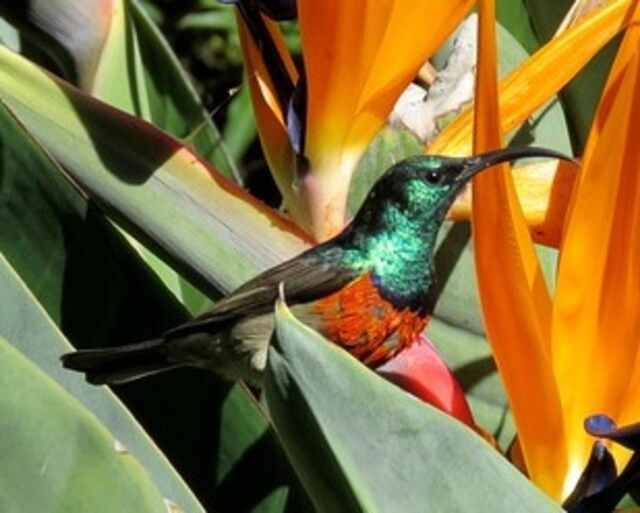
Appearance and Habitat
The Orange-Breasted Sunbird is a petite avian species, measuring between 12-17 cm in length and weighing approximately 10 grams. They can be located in the eastern and southern regions of Africa. The male of the species is a magnificent sunbird, boasting a vibrant orange-colored abdomen, a lustrous purple band across its breast, and a shimmering green head.
On the other hand, the female and juvenile birds are rather unremarkable, displaying a dull olive coloration with marginally lighter undersides. They have a long, downward curved beak that is specially adapted for feeding on nectar from flowers.
The Orange Breasted Sunbird is found in a variety of fynbos habitats, including shrublands, heathlands, and forests. They are also found in urban areas, where they are known to feed on flowering plants in gardens.
Diet and Behavior
The Orange Breasted Sunbird primarily feeds on nectar from flowers, but they also consume small insects and spiders for protein. They are known for their territorial behavior and will defend feeding territories against other sunbirds and even larger birds.
Similarities and Differences with Hummingbirds
In terms of similarities and differences with other species of sunbirds and hummingbirds, the Orange Breasted Sunbird is unique in its distribution range, habitat, and appearance. It is only found in South Africa, while other sunbirds and hummingbirds are found in other parts of Africa and around the world.
Its fynbos habitat is also distinct from other sunbird and hummingbird habitats, which are often tropical or subtropical forests. Its long, curved beak is also unique compared to other sunbird and hummingbird beaks, which are often straight or only slightly curved.
However, like other sunbirds and hummingbirds, the Orange Breasted Sunbird has a nectar-based diet and is an important pollinator for many flowering plants.
Southern Double-Collared Sunbird
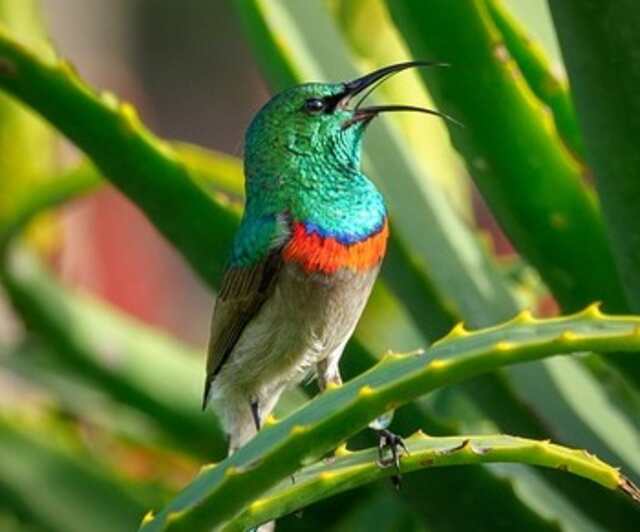
Appearance and Habitat
The Southern Double-Collared Sunbird (Hedydipna collaris) is a small bird found in the coastal forests and adjacent woodlands of southern and eastern Africa. The males have iridescent green plumage on their upperparts, black wings and tail, and a distinctive orange collar on their necks.
Females have duller plumage with a green back and grayish underparts. They have a relatively short, slightly curved downward beak that is specially adapted for feeding on nectar from flowers.
The Southern Double-Collared Sunbird is found in a variety of habitats, including coastal forests, riverine forests, and woodland areas. They are often found near flowering plants, where they feed on nectar.
Diet and Behavior
The Southern Double-Collared Sunbird primarily feeds on nectar from flowers, but they also consume small insects and spiders for protein. They are known for their territorial behavior and will defend feeding territories against other sunbirds and even larger birds.
The Southern Double-Collared Sunbirds are diurnal, and they dedicate a significant portion of their time to search for food.
Similarities and Differences with Hummingbirds
In terms of similarities and differences with hummingbirds, the Southern Double-Collared Sunbird is similar in its nectar-based diet and important role as a pollinator for many flowering plants. It is apparent that there are discernible variations between the two.
The Southern Double-Collared Sunbird is found only in southern and eastern Africa, while hummingbirds are found primarily in the Americas. The Southern Double-Collared Sunbird is also slightly larger than most hummingbird species, and its beak is shorter and straighter.
Additionally, the plumage of the Southern Double-Collared Sunbird is different from that of most hummingbirds, with the males having a distinctive white collar on their necks.
Despite these differences, both the Southern Double-Collared Sunbird and hummingbirds are important pollinators and fascinating species to observe in the wild.
Crimson Sunbird

Appearance and Habitat
The Crimson Sunbird (Aethopyga siparaja) is a small, brightly colored bird found in Southeast Asia. It measures around 10 cm in length and weighs only a few grams.
The males have vibrant crimson plumage on their head, neck, breast, and upperparts, while the females have olive-green plumage with yellow underparts.
They have a slightly curved beak that is specially adapted for feeding on nectar from flowers. The Crimson Sunbird is found in a variety of habitats, including forests, gardens, and parks.
They are often found in the upper canopy of trees, where they feed on nectar from flowers and insects.
Diet and Behavior
The Crimson Sunbird primarily feeds on nectar from flowers, but they also consume small insects and spiders for protein.
They are known for their acrobatic flight and will hover in front of flowers to feed. They are also territorial birds and will defend feeding territories against other birds.
Similarities and Differences with Hummingbirds
The Crimson Sunbird has many similarities with hummingbirds, including its nectar-based diet, small size, and ability to hover in flight. Nevertheless, there exist certain disparities amid the two groups. One major difference is their geographic distribution.
While hummingbirds are found mainly in the Americas, the Crimson Sunbird is found in Southeast Asia. Another difference is their beak shape; hummingbirds have a straight beak, while the Crimson Sunbird has a slightly curved beak.
Finally, their plumage and coloration differ as well; while some hummingbirds have bright, iridescent plumage, the Crimson Sunbird has distinct crimson and olive-green coloration.
Malachite Sunbird
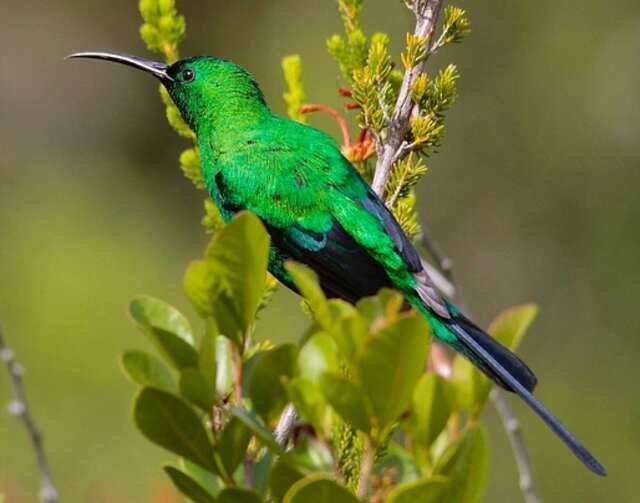
Appearance and Habitat
The Malachite Sunbird (Nectarinia famosa) is a small passerine bird found in southern and eastern Africa. The males have iridescent green feathers on their head, throat, back, and chest, while the females have olive-brown feathers with a reddish-brown throat.
They have long, curved bills that are used to extract nectar from flowers, and they also consume small insects and spiders for protein.
The Malachite Sunbird is found in a variety of habitats, including fynbos, forests, and savannahs. They are also found in urban areas, where they are known to feed on flowering plants in gardens.
Diet and Behavior
The Malachite Sunbird primarily feeds on nectar from flowers, but they also consume small insects and spiders for protein.
They are known for their territorial behavior and will defend feeding territories against other sunbirds and even larger birds. They are also known for their elaborate courtship displays, which involve hovering and calling.
Similarities and Differences with Hummingbirds
The Malachite Sunbird is similar to hummingbirds in its nectar-based diet and ability to hover in front of flowers to feed. However, there are distinct dissimilarities among the two groups. The Malachite Sunbird is found only in Africa, while hummingbirds are found in the Americas.
Hummingbirds have longer wings and are capable of sustained hovering, while sunbirds have shorter wings and use a more labored flight style.
Additionally, sunbirds have curved beaks while hummingbirds have straight beaks. Overall, while they share some similarities, the Malachite Sunbird and hummingbirds are distinct groups of birds.
Malagasy Green Sunbird

Appearance and Habitat
The Malagasy Green Sunbird (Cyanomitra olivacea) is an Old World nectar-feeding bird that is endemic to the eastern rainforests of Madagascar’s coastal region. These small birds are around 15 cm in length and have a glossy green plumage with a black belly.
They can be found in a variety of forest habitats, including rainforests, dry forests, and montane forests. They can also be found in degraded and secondary forests, as well as urban areas.
Diet and Behavior
The Malagasy Green Sunbird primarily feeds on nectar from flowers, but they also consume small insects and spiders for protein. They are known for their territorial behavior and will defend feeding territories against other sunbirds and even larger birds.
Similarities and Differences with Hummingbirds
Although both the Malagasy Green Sunbird and hummingbirds have a nectar-based diet and play important roles in pollinating flowering plants in their respective habitats, they have notable differences. The Malagasy Green Sunbird is not closely related to hummingbirds, and it is an Old World nectar-feeding bird in the family Nectariniidae, which is found in Africa and Asia.
In contrast, hummingbirds belong to the family Trochilidae, which is found only in the Americas. Additionally, the beak of hummingbirds is typically longer and more curved than that of sunbirds. Hummingbirds also tend to be smaller than sunbirds, and their plumage often includes bright colors such as red, orange, and purple.
Javan Sunbird
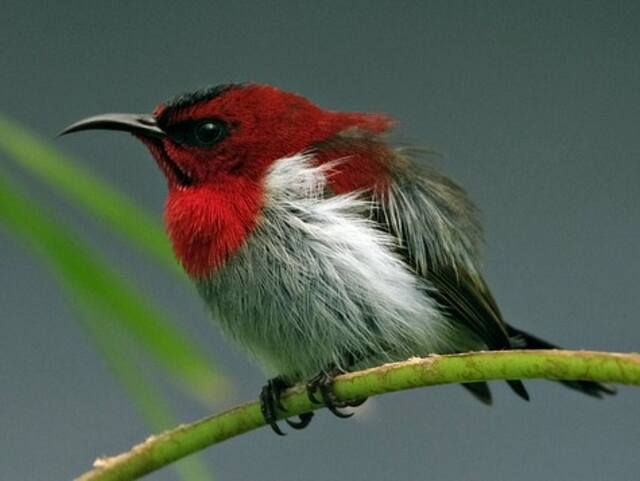
Appearance and Habitat
The Javan Sunbird (Aethopyga mystacalis) is a small bird found in the rainforests and mountainous regions of Java and Bali in Indonesia.
The male Javan Sunbird has a distinctive appearance, with a crimson-colored head, neck, and upper back, an iridescent purple crown and cheek stripe, and white on the sides and belly.
Females, on the other hand, are mostly brown with some green plumage. They have a curved beak adapted for feeding on nectar from flowers.
Diet and Behavior
The Javan Sunbird primarily feeds on nectar from flowers, but also consumes insects and spiders for protein. They are territorial and defend their feeding territories against other sunbirds and even larger birds.
They are known for their acrobatic flight patterns and display behaviors during courtship. Furthermore, they breed throughout the year, building small, cup-shaped nests out of leaves, moss, and spider webs.
Similarities and Differences with Hummingbirds
Like hummingbirds, the Javan Sunbird has a nectar-based diet and plays an important role in pollinating many flowering plants. However, it differs from hummingbirds in its distribution range, as it is only found in Java and Bali in Indonesia.
Its curved beak is also unique compared to other sunbird and hummingbird beaks, which are often straight or only slightly curved. The Javan Sunbird is larger than most hummingbirds, measuring around 12-13 cm in length, and has a more upright perching posture.
Lesser Double-Collared Sunbird
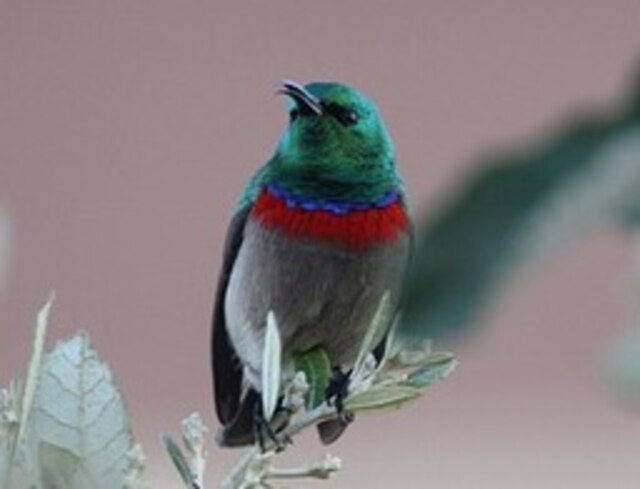
Appearance and Habitat
The Lesser Double-Collared Sunbird (Cinnyris chalybeus) is a burst of color in the African sky. This small bird, measuring around 12 cm in length, boasts iridescent green and black plumage on the head, throat, upper breast, and back of adult males.
A stunning red band across the chest is separated from the green breast by a narrow metallic blue band. The underparts are mostly whitish, providing a stark contrast to the vibrant colors on the rest of the bird.
The Lesser Double-Collared Sunbird can be found in a variety of habitats throughout Southern Africa, from gardens to forests and fynbos shrublands.
However, it is most commonly found in montane forests and woodland areas. These birds have a slender, downward-curving beak specially adapted for feeding on nectar from flowers.
Diet and Behavior
The Lesser Double-Collared Sunbird primarily feeds on nectar from flowers, but they also consume small insects and spiders for protein.
They are known for their territorial behavior and will defend feeding territories against other sunbirds and even larger birds. They are also active and acrobatic, often hovering in front of flowers while feeding.
Similarities and Differences with Hummingbirds
When it comes to similarities and differences with hummingbirds, the Lesser Double-Collared Sunbird is similar in appearance and behavior, as both have slender, downward-curving beaks adapted for feeding on nectar and are active and acrobatic while feeding. However, the Lesser Double-Collared Sunbird is only found in Africa, while hummingbirds are found in the Americas.
Additionally, hummingbirds have a wider variety of habitats, including tropical rainforests and deserts, while the Lesser Double-Collared Sunbird is primarily found in montane forests and woodland areas in Southern Africa.
Purple-Throated Sunbird
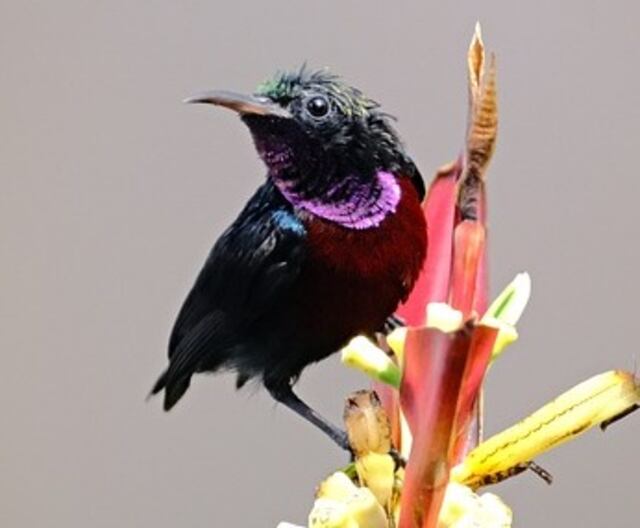
Appearance and Habitat
The Purple-Throated Sunbird (Leptocoma sperata) is a small bird found in Southeast Asia, including India, Sri Lanka, and Myanmar. The males have a distinctive purple throat patch and red belly, while the females have a duller brown and white below.
They have a slightly curved beak that is adapted for feeding on nectar from flowers. The Purple-Throated Sunbird is found in a variety of habitats, including forests, scrublands, and gardens.
They are known to be highly adaptable and can thrive in urban areas where flowering plants are available.
Diet and Behavior
The Purple-Throated Sunbird primarily feeds on nectar from flowers, but they also consume small insects and spiders for protein.
They are highly active and can be seen darting between flowers in search of food. They are also known for their territorial behavior and will defend feeding territories against other sunbirds and hummingbirds.
Similarities and Differences with Hummingbirds
The Purple-Throated Sunbird shares many similarities with hummingbirds, including their nectar-based diet and ability to hover in front of flowers while feeding. However, there are also several key differences between these two groups of birds.
One significant difference is their geographic distribution. While hummingbirds are found exclusively in the Americas, sunbirds are found in Africa and Asia. Another difference is in their size, with hummingbirds generally being smaller than sunbirds.
Additionally, hummingbirds have a higher metabolism and are capable of sustained hovering flight, while sunbirds primarily perch and fly in short bursts.
Finally, hummingbirds have a unique wing structure that allows for more precise control in flight, while sunbirds have a more conventional bird wing structure.
Black Sunbird
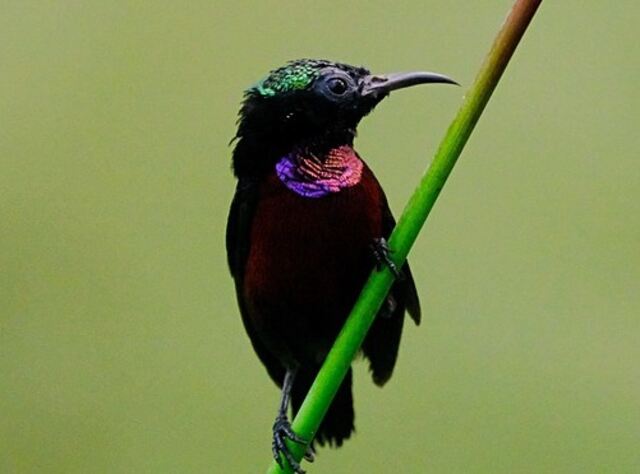
Appearance and Habitat
The Black Sunbird (Leptocoma sericea) is a small, passerine bird species found in the Indian subcontinent and Southeast Asia. The male has glossy black plumage with a metallic blue-green sheen on its head and back.
The female is less showy, with duller plumage and a greenish-brown back. They have a slightly curved, thin beak that is used to extract nectar from flowers.
The Black Sunbird is found in a variety of habitats, including forests, gardens, and urban areas. They are often seen flitting among flowers and shrubs, feeding on nectar.
Diet and Behavior
The Black Sunbird primarily feeds on nectar from flowers, but they also consume small insects and spiders for protein. They are known for their acrobatic flight patterns and are often seen hovering or hanging upside down while feeding.
The male Black Sunbird is also known for its courtship displays, which involve flitting around the female and showing off its iridescent plumage.
Similarities and Differences with Hummingbirds
The Black Sunbird is similar to hummingbirds in that it has a nectar-based diet and is an important pollinator for many flowering plants. Nevertheless, there are noteworthy differences that separate the two.
While hummingbirds are found exclusively in the Americas, the Black Sunbird is found in the Indian subcontinent and Southeast Asia.
Additionally, hummingbirds have a unique wing structure that allows for hovering flight, while the Black Sunbird relies on a combination of flapping and gliding to move through the air.
Finally, hummingbirds are generally smaller and more lightweight than the Black Sunbird, with some species weighing as little as 2–3 grams. The Black Sunbird, on the other hand, weighs between 7–12 grams.
Purple Sunbird
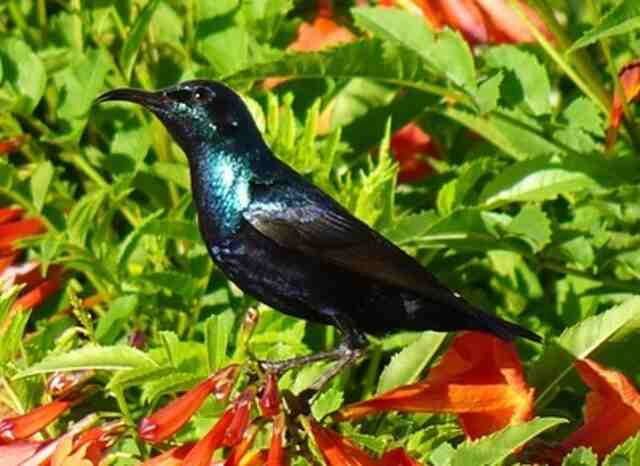
Appearance and Habitat
The Purple Sunbird (Cinnyris asiaticus) is a small bird found in a wide range of habitats across South and Southeast Asia, from forests and woodlands to gardens and parks.
The males have iridescent purple-blue plumage on their head, neck, and upperparts, with a black mask and orange-brown underparts.
The females have duller plumage with a yellowish-brown underparts and a whitish throat. They have a long, curved beak that is specially adapted for feeding on nectar from flowers.
Diet and Behavior
The Purple Sunbird primarily feeds on nectar from flowers, but they also consume small insects and spiders for protein.
They are known for their territorial behavior and will defend feeding territories against other sunbirds and even larger birds. They are also active and acrobatic birds, often seen hovering in front of flowers to feed.
Similarities and Differences with Hummingbirds
In terms of similarities and differences with hummingbirds, the Purple Sunbird is similar in its nectar-based diet and its role as a pollinator for many flowering plants. However, the Purple Sunbird is not a hummingbird, as it belongs to a different family of birds, the sunbirds.
Unlike hummingbirds, sunbirds are found primarily in Africa and Asia and have a wider range of habitats, including forests, woodlands, and even urban areas. While both hummingbirds and sunbirds have long, curved beaks for feeding on nectar, the beak of the Purple Sunbird is not as long or as curved as that of many hummingbird species.
Additionally, the plumage of the Purple Sunbird is distinct from most hummingbirds, with its iridescent purple-blue coloration on the male’s head, neck, and upperparts.
Temminck’s Sunbird
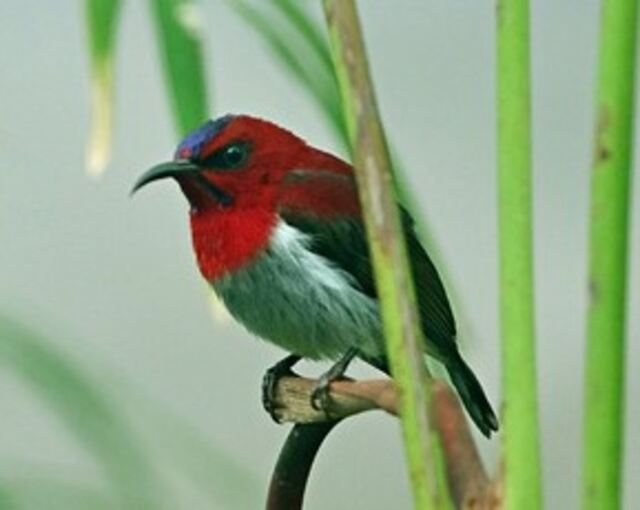
Appearance and Habitat
Temminck’s Sunbird (Nectarinia temminckii) is a small bird found in sub-Saharan Africa. This species measures around 10 cm in length and weighs only a few grams.
The males have iridescent green and purple plumage on their head, throat, and chest, while the females have duller plumage with a green back and yellow belly.
They have a thin, downward-curved beak that is specially adapted for feeding on nectar from flowers. Temminck’s Sunbird is found in a variety of habitats, including savannas, woodlands, and gardens.
They are known to visit flowering trees and shrubs in search of nectar, and will also consume small insects and spiders for protein.
Diet and Behavior
Temminck’s Sunbird primarily feeds on nectar from flowers, but they also consume small insects and spiders for protein. They are known for their territorial behavior and will defend feeding territories against other sunbirds and even larger birds.
They are also known to perform courtship displays, with the male flying in a U-shaped pattern while singing to attract a mate.
Similarities and Differences with Hummingbirds
Temminck’s Sunbird is similar to hummingbirds in their nectar-based diet and their role as pollinators. However, they are distinct from hummingbirds in their appearance, with a thin, downward-curved beak instead of a long, straight one.
They are also only found in Africa, while hummingbirds are found primarily in the Americas. Additionally, hummingbirds are capable of hovering in place while feeding, while sunbirds like Temminck’s Sunbird perch on flowers or branches to feed.
Olive-Backed Sunbird
Appearance and Habitat
The Olive-Backed Sunbird (Cinnyris jugularis) is a tiny passerine bird that inhabits tropical and subtropical regions of the Old World. The male has a lustrous olive-colored back, gleaming with iridescent bluish-green and dark purple hues on the neck and chest.
Its wings are grayish-brown, and its belly is a bright shade of yellow. The female, on the other hand, has a more subdued olive-brown back. They have a long, down curved beak that is specially adapted for sipping nectar from flowers.
The Olive-Backed Sunbird can be found in diverse habitats, including rainforests, mangroves, and urban areas with flowering trees and shrubs. They are most commonly found in Southeast Asia, the Indian subcontinent, and parts of Australia.
Diet and Behavior
The Olive-Backed Sunbird primarily feeds on nectar from flowers, but they also consume small insects and spiders for protein. They are known for their territorial behavior and will defend feeding territories against other sunbirds and even larger birds.
They also build nests that are suspended from tree branches, which are made of plant fibers, spider webs, and feathers.
Similarities and Differences with Hummingbirds
The Olive-Backed Sunbird is similar to hummingbirds in their nectar-based diet, feeding behavior, and small size. However, they are not closely related to hummingbirds and belong to a different family of birds.
Hummingbirds are found only in the Americas, while the Olive-Backed Sunbird is found in other parts of the world. Additionally, hummingbirds have a unique ability to hover in midair while feeding, which is not seen in sunbirds.
Sunbirds, on the other hand, have a more varied diet than hummingbirds, as they also feed on insects and spiders.
New Holland Honeyeater
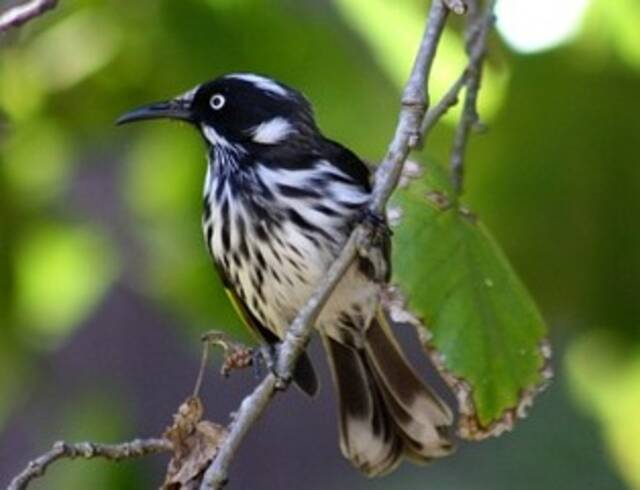
Appearance and Habitat
The New Holland Honeyeater (Phylidonyris novaehollandiae) is a medium-sized bird that measures around 18 cm in length and weighs around 20 grams. They have a distinctive black and white striped plumage on their head and neck, with brownish-gray wings and a white belly.
They have a long, curved beak that is specially adapted for feeding on nectar from flowers. The New Holland Honeyeater is found in a variety of habitats in southwestern Australia, including woodlands, forests, and gardens.
They are also known to visit parks and suburban areas, where they feed on flowering plants.
Diet and Behavior
The New Holland Honeyeater primarily feeds on nectar from flowers, but they also consume insects, spiders, and fruit for protein.
They are known for their aggressive behavior towards other honeyeaters and birds, particularly during the breeding season, when they defend their nesting territories. They are also vocal birds and have a variety of calls and songs.
Similarities and Differences with Hummingbirds
In terms of similarities and differences with hummingbirds, the New Holland Honeyeater is similar in its nectar-based diet and role as a pollinator for flowering plants. However, it differs from hummingbirds in several ways.
Firstly, it is not a true hummingbird but belongs to the honeyeater family, which is found only in Australia and nearby islands. Secondly, it is not as small or fast-flying as hummingbirds and does not hover as much.
Lastly, its curved beak is not as long as the beak of some hummingbirds and is not as perfectly adapted for feeding on certain types of flowers.
Eastern Spinebill
Appearance and Habitat
The Eastern Spinebill (Acanthorhynchus tenuirostris) is a small passerine bird that can be found in the southeastern region of Australia. It measures between 13-16 cm in length and weighs around 7–12 grams. The males of the species are distinguished by their glossy black feathers, with gray inner wings and tail.
They also sport a white bib that extends to their belly, as well as a smaller brown bib that only covers the throat. The lower breast and belly feature a light brown to yellow-brown hue. Males can be differentiated from females by the color of their crown, which is black in males and gray in females.
The Eastern Spinebill has adapted to various habitats, including open forests, woodlands, heathlands, and gardens, and is frequently seen visiting flowering shrubs and trees.
Diet and Behavior
The Eastern Spinebill primarily feeds on nectar from flowers, but they also consume small insects and spiders for protein. They have a long, curved beak that is specially adapted for reaching deep into flowers to extract nectar. They are also known for their hovering behavior while feeding, similar to hummingbirds.
Eastern Spinebills are solitary birds, except during the breeding season, when they form monogamous pairs. They defend territories against other birds and are known for their distinctive and loud vocalizations.
Similarities and Differences with Hummingbirds
Eastern Spinebills are often compared to hummingbirds due to their small size and hovering feeding behavior. However, they are not actually hummingbirds but belong to a different family of birds, the honeyeaters.
While they share some similarities with hummingbirds, such as their nectar-based diet and hovering behavior, they also have some significant differences. For example, Eastern Spinebills are found only in Australia, while hummingbirds are found only in the Americas.
Additionally, Eastern Spinebills have a longer beak that is more curved than most hummingbirds. Finally, while both Eastern Spinebills and hummingbirds are important pollinators, they pollinate different plant species due to their different geographic ranges.
Brown-Throated Sunbird
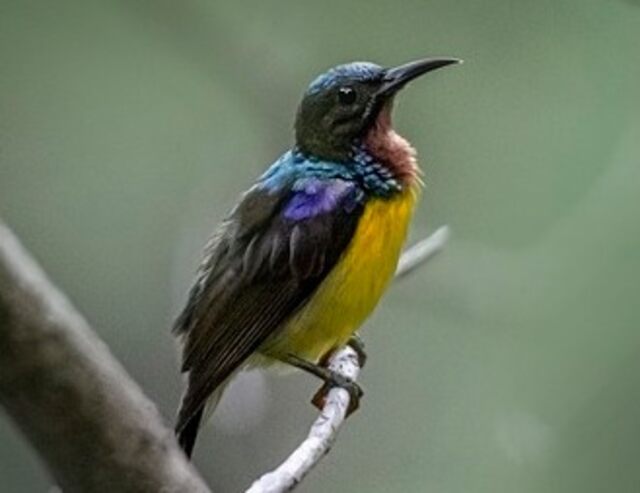
Appearance and Habitat
The Brown-Throated Sunbird (Anthreptes malacensis) is a small bird found in tropical and subtropical regions of Southeast Asia. This species measures around 14 cm in length and weighs only 8–14 grams.
The males have iridescent green and bluish-purple plumage on their head and back, with reddish-brown wings and yellow belly, while the females have duller plumage with a green back and yellow belly. They have a short, straight beak that is adapted for feeding on nectar from flowers.
The Brown-Throated Sunbird is found in a variety of habitats, including forests, gardens, and plantations. They are typically found in the lowlands but can also be found in mountainous regions up to an altitude of 2,000 meters.
Diet and Behavior
The Brown-Throated Sunbird primarily feeds on nectar from flowers, but they also consume small insects and spiders for protein. They are known for their acrobatic feeding behavior and can hover and fly backwards like hummingbirds.
They are also known for their territorial behavior and will defend feeding territories against other sunbirds and even larger birds.
Similarities and Differences with Hummingbirds
The Brown-Throated Sunbird shares many similarities with hummingbirds. Both have a nectar-based diet and are important pollinators for many flowering plants. Both are also known for their acrobatic feeding behavior, hovering, and flying backward.
However, there are also some differences between the Brown-Throated Sunbird and hummingbirds. The Brown-Throated Sunbird has a short, straight beak, while hummingbirds typically have long, curved beaks. Additionally, hummingbirds are found only in the Americas, while the Brown-Throated Sunbird is found in Southeast Asia.
Their plumage is also different, with the Brown-Throated Sunbird having green and blue iridescent feathers on the head and back, and the hummingbird having iridescent feathers in a wider range of colors on the head, back, and belly.
Collared Sunbird
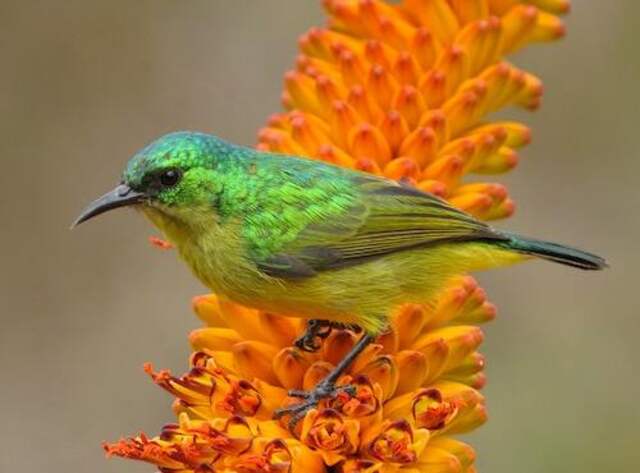
Appearance and Habitat
The Collared Sunbird (Hedydipna collaris) can be found in Eastern and Southern Africa and is a small bird. The males have a metallic green back and a yellow belly. Additionally, the male has a green throat and a narrow purplish strip on its breast, while the female is less vibrant with a yellow throat and no breast stripe.
They measure around 11 cm in length and weigh only 5–11 grams. The Collared Sunbird is found in a variety of habitats, including forests, savannas, and gardens. They are often found near flowering plants and are known to feed on nectar from a variety of flowers.
Diet and Behavior
The Collared Sunbird primarily feeds on nectar from flowers, but they also consume small insects and spiders for protein.
They are known for their acrobatic flight patterns and can hover in front of flowers while feeding. They are also territorial and will defend feeding territories against other Sunbirds and even larger birds.
Similarities and Differences with Hummingbirds
In terms of similarities and differences with hummingbirds, the Collared Sunbird is similar in its nectar-based diet and acrobatic flight patterns. However, it differs in its distribution range, habitat, and appearance.
Collared Sunbirds are only found in eastern and Southern Africa, while hummingbirds are found in the Americas. The Collared Sunbird is also found in a wider variety of habitats than hummingbirds, which are often associated with tropical or subtropical forests.
Finally, the Collared Sunbird’s white collar is a distinctive feature that sets it apart from hummingbirds, which lack this feature.
Scarlet Honeyeater
Appearance and Habitat
The Scarlet Honeyeater (Myzomela sanguinolenta) is a small bird found in the woodlands, forests, and coastal heaths of Australia and nearby islands.
The male Scarlet Honeyeater has bright red plumage with black wings, while the female has olive-green upperparts and yellowish underparts. They have a short, curved beak that is used for feeding on nectar and insects.
Diet and Behavior
The Scarlet Honeyeater primarily feeds on nectar from flowers, but they also consume small insects and spiders for protein.
They are known for their aggressive behavior, often chasing other birds away from their feeding territories. They are also known for their acrobatic flying skills, hovering in front of flowers while feeding.
Similarities and Differences with Hummingbirds
The Scarlet Honeyeater is similar to hummingbirds in its nectar-based diet and small size, measuring around 8 cm in length.
However, it is not closely related to hummingbirds, which are only found in the Americas. The Scarlet Honeyeater is also unique in its appearance, with bright red plumage in males and olive-green in females.
In contrast, hummingbirds have a wide range of colors and plumage patterns. Additionally, hummingbirds have a longer, straighter beak compared to the Scarlet Honeyeater’s short, curved beak.
Conclusion
In conclusion, exploring the world of birds can be a fascinating experience, especially when you discover the amazing variety of hummingbird lookalikes out there. From the Scarlet Honeyeater to the Sunbird, these birds showcase the wonder and diversity of nature.
Bursting with vibrant colors and unique features, they remind us of the beauty and complexity of the world around us. So why not grab a pair of binoculars and start birdwatching today? You never know what other amazing discoveries you might make.
Related Post:

